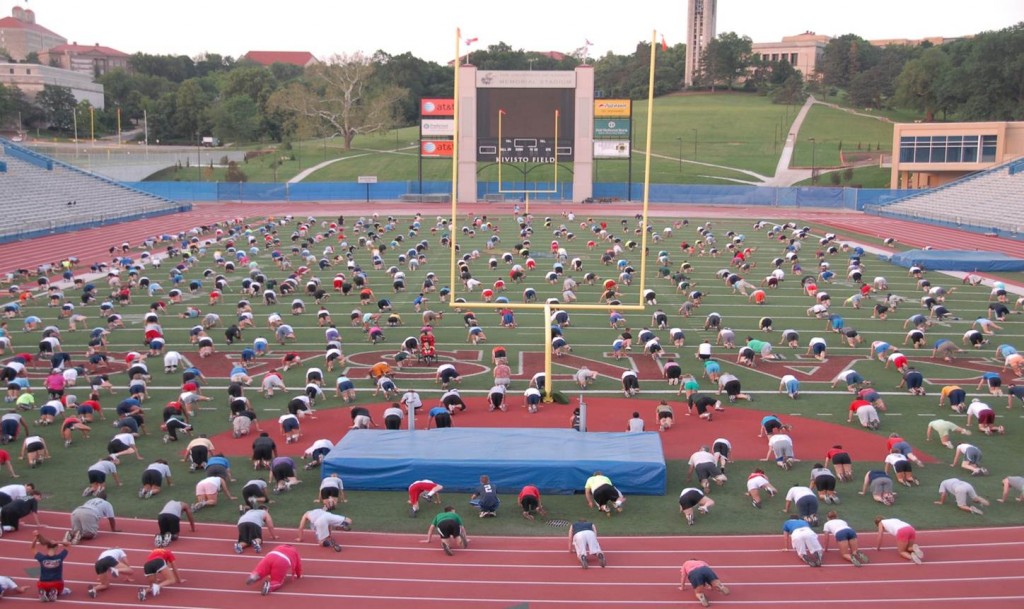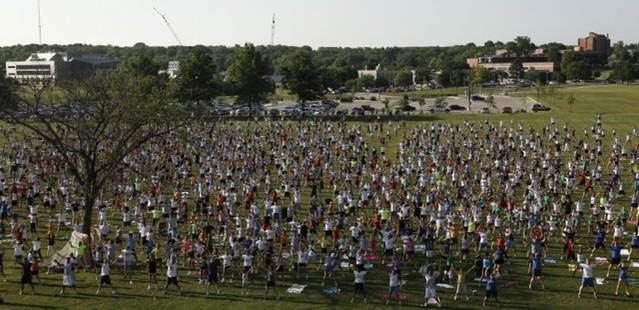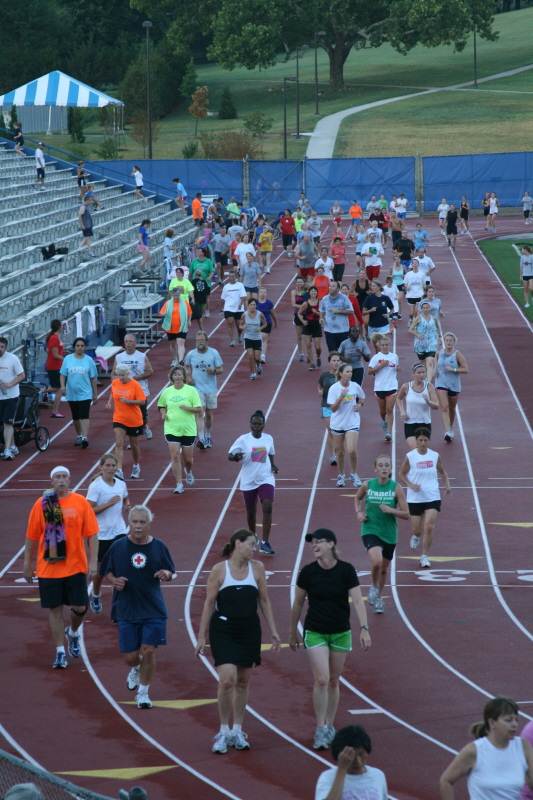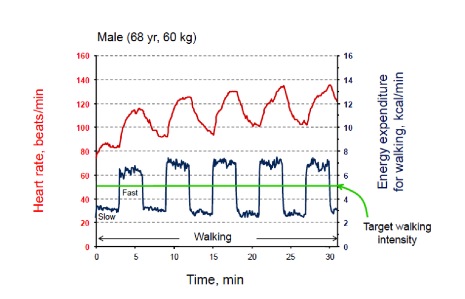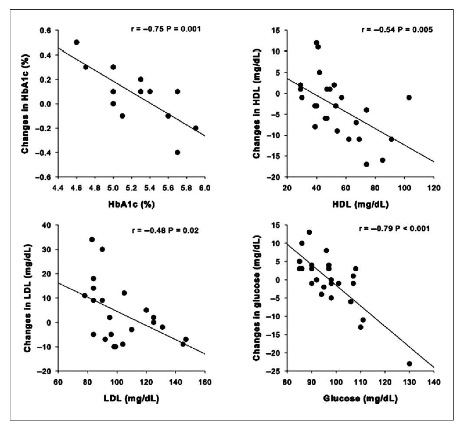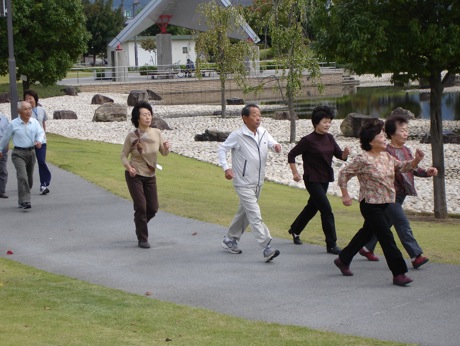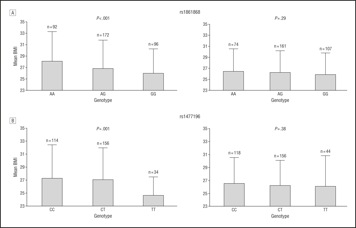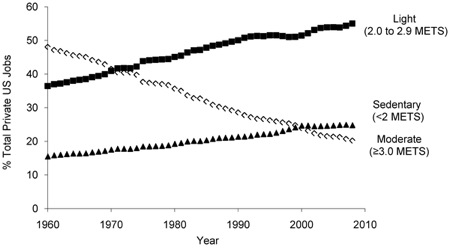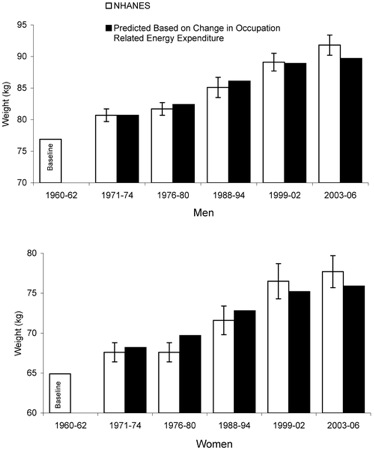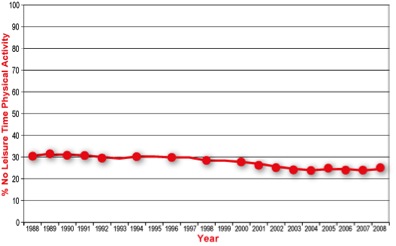Archive for the ‘Research and Health’ Category
Community Based Fitness – Lawrence, KS
I have been bombarding you with statistics about inactivity and obesity over the last few weeks. Today we have a guest post from Drs. Carrie Quinn and Sandy Billinger from the University of Kansas about a novel approach to community based fitness in Lawrence, Kansas. I first heard about this program when I was at the med-school in Kansas City giving a talk at their “Exercise is Medicine” symposia last May. The presentation on “Red Dog Days” was so impressive that I thought it would be a good thing to share. There are lots of messages here, but perhaps the main one is that with a little creativity, community fitness programs can be generated for little or no cost. They can also be multi-generational and fun. So, I guess the only thing left to say is “Rock Chalk, Jayhawk” and let Sandy and Carrie tell the story.
Dog Days
One Lawrence, Kansas resident has managed to become the envy of exercise professionals everywhere. Mr. Don “Red Dog” Gardner has done what most thought was impossible: built a free, community-based exercise program that has withstood the test of time.
Nearly thirty years ago Red Dog started using his military training and sports medicine acumen to help six local football players achieve increased fitness. Year after year the numbers increased. Students brought siblings, siblings and students brought parents, parents brought friends, and friends brought neighbors until Red Dog’s basic fitness program exploded into a multi-generational, all-are-welcome, free exercise program serving upwards of 500 people per day.
Always ambitious, Red Dog’s desire lead exercise en masse didn’t end with the development of his program, known as Dog Days. In July of 2009, Red Dog and his loyal group of exercisers made a run at a World Record: the world’s largest workout. Though Guiness overlooked the accomplishment, Red Dog’s World’s Largest Workout boasted numbers of over 2700 individuals exercising at the same time. That’s community-based success.
Exercise professionals are in awe of this phenomenon. We struggle to get our patients and clients to exercise regularly. We battle the roadblocks of time and location and convenience in an effort to make exercise more accessible. And here is one individual that makes the development of a community-based exercise program look effortless. He says, in essence,
“Come exercise with us, and bring your friends. It’s free and built just for you. No pressure. No worries. Do what you can, at your own pace, and meet hundreds of others who will support you and every step you take.”
Though, to the exercisers, the program organization looks effortless, but Red Dog knows the success is due to a very precise combination of ingredients. It starts with a commitment, not only his own commitment to planning and organizing daily events for 500 exercisers, but commitment from his all-volunteer staff. A staff that is absolutely essential to the success of the program. Red Dog’s formula for a successful community-exercise program are:
- A charismatic leader
- A behind the scenes organizer
- Volunteers, volunteers, volunteers
- Strong set of rules and values
- Facilities
- Donor support
- Social opportunities
And what’s the payoff for the exerciser? A coveted t-shirt. Not sold in stores and never simply given away. Worn proudly as a badge of honor, those who earn a Dog Day’s t-shirt know the meaning of accomplishment. They’ve gutted out the workouts and earned their place in line. Remember, too, Dog Day’s is free. That means, the design, purchase and distribution of these t-shirts is due to the diligent fundraising of Red Dog and his team. And this is where community involvement really gels and comes full circle. Asking the local businesses to support the community effort makes everyone accountable for this exercise movement that started with 6 football players back in 1984.
If you find yourself in Lawrence, Kansas, even if just passing through, look up Red Dog, spend some time at his Dog Days, and you’ll see that getting people to exercise really isn’t that hard after all.
http://reddogsdogdays.org/Home.php
What About Diet?
My recent focus on physical activity and obesity leads to an important question. How much of the big increase in obesity rates seen in the U.S. over the last 30 or so years is due to what we eat? Like some of my earlier posts on physical activity and obesity this one is going to be data intensive.
We are eating more!
The U.S. Department of Agriculture (USDA) reports interesting statistics on what people are eating in the U.S. The figure below shows trends in calories per person. The top line is total food supply. The bottom line is an estimate of what people might actually be eating. As the title of slide indicates there has been about a 19% increase sine the early 1980s. This is equal to about 400 calories per day!
Clearly these are average statistics and there is all sorts of individual variability related to what people eat. However, the story for society as a whole is pretty alarming. If these changes in consumption are not offset by at least some increased energy expenditure this would work out to a pound of weight gain every 9 days or about 40 pounds (18kg) per year based on the idea that a pound of fat is 3500 calories of excess energy consumption.
The USDA statistics about increased calorie consumption have been challenged and better estimates are shown below for all adults (ALL), normal weight (NW), overweight (OW), and obese (OB) adults in the U.S. These data compare estimates made in the early 1970s to data from 2005-2006.
So, if we use these data, about 200 calories per day, then we would expect people to gain about 20 lbs (9kg) per year. Also remember from my earlier posts only about 5% of people are meeting the guidelines for physical activity and there has been an average loss of about 100-150 calories a day of physical activity at work for many people.
When you see statistics like this the question isn’t why is the population getting fatter, the question is why isn’t the population getting even fatter!
We are less fat than predicted!
The figure below shows the average adult is “only” about 10kg heavier now then in the early 70s when caloric consumption starts to rise. This figure comes from an excellent paper with a lot mathematical modeling on how and why our energy expenditure goes up when we eat too much and why it goes down when we diet.
1975 2010
Here is a link to a simulator you can use to project changes in your body weight with dieting using the computer models that generated the simulated changes in body weight noted above.
So the good news is that it is actually pretty hard to gain weight and that the combination of a lot of extra calories and a lot less activity is required to pack the pounds on. The bad news is that these same principles apply in reverse and make it hard to lose weight. The figure below from the modeling paper is an example or what happens to most people when they try to lose weight.
The bottom panel shows a baseline energy consumption of 10 Mega Joules or about 2500 calories per day. Dieting starts and people reduce their caloric consumption by 30-35% but unless they really start to exercise the energy consumption also goes down. After a couple of months their eating begins to pick back up, but energy expenditure is still down and weight begins to creep back up over the next couple of year. This pattern of weight gain is shown in the top panel. The other interesting thing is just how much inter individual variation there is both total weight loss, energy expenditure and how they interact over time.
The concepts outlined in this figure explains why the National Weight Control Registry data on successful long term “losers” shows that a combination of a low calorie diet and high levels of physical activity are required to take and keep weight off over time. In coming posts I will try to figure out where the extra calories are coming from over the last 30-40 years and why there is not a linear relationship between eating less (or becoming more active) and losing weight.
Real Biggest Losers?
Clues from the National Weight Control Registry (NWCR)
A number of my recent posts have focused on the related problems of inactivity and obesity. Losing weight is a hard thing to do and in this post I want to touch on a few things associated with big time sustained weight loss.
Weight loss is hard, studies show that it is possible for many people to lose about 10% of their body weight in structured programs but over the next several years most (about 90%) regain the weight. It is pretty easy to focus on why people regain the weight they have lost and there are all sorts of reasons to explain it, but what about the people who keep the weight off?
The NWCR is open to people over 18 who have lost at least 30 pounds (14kg) and kept it off for at least a year and there is data on more than 10,000 successful long term “losers”. The NWCR site also has some interesting case stories that might be of use for people struggling to lose weight and/or maintain their weight loss.
Here are a few key findings from the NWCR web site.
- 80% of persons in the registry are women and 20% are men. The “average” woman is 45 years of age and currently weighs 145 lbs, while the “average” man is 49 years of age and currently weighs 190 lbs.
- Registry members have lost an average of 66 lbs and kept it off for 5.5 years. These averages, however, hide a lot of diversity:
- Weight losses have ranged from 30 to 300 lbs.
- Duration of successful weight loss has ranged from 1 year to 66 years!
- Some have lost the weight rapidly, while others have lost weight very slowly–over as many as 14 years.
- 45% of registry participants lost the weight on their own and the other 55% lost weight with the help of some type of program.
- 98% of Registry participants report that they modified their food intake in some way to lose weight.
- 94% increased their physical activity, with the most frequently reported form of activity being walking.
- There is variety in how NWCR members keep the weight off. Most report continuing to maintain a low calorie, low fat diet and doing high levels of activity.
- 78% eat breakfast every day.
- 75% weigh themselves at least once a week.
- 62% watch less than 10 hours of TV per week.
- 90% exercise, on average, about 1 hour per day.
What I find interesting is that people who lose a lot of weight and keep it off are exercising about an hour a day. They also appear to be extremely vigilant about their body weight. There is a link to all of the scientific research the NWCR has generate on the web site for those interested in even more data.
When I look at some of the numbers associated with physical activity and the obesity epidemic presented in the earlier posts, the NWCR “biggest losers” would seem to be at the upper end of the guidelines for physical activity. So not getting fat is dependent on high levels physical activity and successful weight loss is dependent on high levels of physical activity.
The other point I want to emphasize is that it is possible for people to regain control of various elements of their lives. It is never too late to be proactive. To emphasize this point, the next section of this post was written by Sheila Ray who is a former co-worker and a successful “loser” and is now a personal fitness trainer and fitness boot camp instructor with her own small business, Reforming U.
Sheila Ray’s Weight Loss Summary
It wasn’t until I was 25 that my 5’8” body began to creep into an unhealthy weight range when I was diagnosed with breast cancer. The surgeries, chemotherapy and radiation were physically and mentally difficult. I was fatigued, which meant I was 100% inactive. I was also warned not to lose weight, so I continued to eat. This was a disastrous combination and I slowly ballooned to 221 pounds, where I stayed for several years.
In 2002, I decided to jump on the “low carb” craze and lost 37 pounds, bringing me down to 184. I didn’t incorporate exercise until after this weight loss, when I began to exercise regularly. There was a problem though. I didn’t realize how strong I was. I didn’t push myself. I became too comfortable with my exercise routine and didn’t see continued results. I also found I couldn’t sustain the “low carb” diet and went back to eating the way I used to eat. Although I stayed faithful to my exercise program, I slowly added weight back on over the next five years and found myself back at 197 pounds.
In early 2008, I began to learn more about health and wellness. I educated myself on a well-balanced life, including healthy, whole nutrition, as well as effective and safe exercise programs. I took control of my life and created happiness like I’ve never experienced before. I cleaned up my diet by eliminating processed foods, laden with chemicals and artificial ingredients, and took control of my daily calorie intake.
I also discovered my strength and began to push myself in my workouts, seeing positive results. I discovered change is not comfortable and I had been comfortable for far too long. I also found my self-pride and self-confidence, because I could do things I never knew possible.
Over six months during 2008, I dropped 40 pounds, which I have been able to maintain. In order to maintain this weight loss, I continue to be aware of the number of calories I consume and burn each day. While I may not be as vigilant as I was during my weight loss phase, I do have a solid understanding of the amount of food and activity I need for that delicate maintenance balance. I eat three well-balanced meals, starting with breakfast within 30 minutes of waking. I also eat one to two snacks between meals, ensuring I do not go more than four hours without eating during the day. I weigh myself often and use clothing as a guide. I exercise four to six days per week, mainly utilizing interval training, with bursts of high intensity activity mixed with active recovery. My passion is helping others achieve the happiness I have.
Before
After
Interval Walking Training
In several recent posts I have focused on physical activity and health and also the link between obesity and inactivity. Not a lot of good news if you look at the population statistics, but good news if you think about just how protective exercise and physical activity are both in terms of obesity and also general health. So, what to do about it?
Perhaps the easiest, cheapest and most convenient form of exercise for most people, especially middle aged (40-65) and older (>65) people is simply walking. One of the best and most effective ways to get the most out of your walking is to do something called Interval Walking Training (IWT). This program was developed in the Japan by my close friend and colleague Hiroshi Nose, and his research team to help thousands of people get into better shape.
The idea is to use the same principles that elite endurance athletes and Olympians do when you go for a walk. To get in the best shape possible the elites do work outs that include multiple 3-5 minute efforts that are nearly all out followed by 2-3 minutes of recovery several times or more per week. Both scientific studies and practical experience suggests that this is a key to getting in the best possible shape. It also gives you incredible “bang for the buck” in terms of time, and what works for the elite athletes can work for us all.
The IWT program consists of 5 or more sets of 3 minutes of low-intensity walking followed by fast walking for 3 minutes four or five times per week. Low intensity walking should be a bit faster than a stroll (40% effort) and higher intensity walking should be at greater than 70% of maximum effort. Hiroshi’s team has used this approach in a number of their studies and they use heart rate monitors and tracking devices called accelerometers to set and measure exercise intensity.
The figure below is one that shows a typical heart rate response and calorie consumption pattern with this type of training in one of the subjects in Japan. It was sent to me by Dr. Shizue Masuki and the data was collected by Dr. Ken Miyagawa, they are both key members of the Nose team. Hiroshi had the following comments about the data:
“As shown in the figure, HR increases to ~130 beats/min during fast walking, but decreases during slow walking, This slow walking or recovery period is important because it motivates a subject to walk at high intensity again. Moreover, because the interval walking training was performed in a hot environment (atmospheric temperature=32 C, RH=60%), HR level increases with increasing body temperature, which makes it difficult to estimate walking intensity from HR accurately. Therefore, it is important to monitor walking intensity with a tri-axial accelerometer.”
Does this work? To quote one of the early papers on IWT:
“In the IWT group, isometric knee extension increased by 13%, isometric knee flexion by 17%, peak aerobic capacity for cycling by 8%, and peak aerobic capacity for walking by 9%, all of which were significantly greater than the increases observed in the moderate-intensity continuous walking training group. Moreover, the reduction in resting systolic blood pressure was higher for the high-intensity interval walking training group.”
Below is a figure from a collaborative study that we did with the team from Japan. It shows what happens to selected inactivity associated risk factors when 26 previously sedentary people (average age 54) followed the program about four days per week for three months. The people with the worst initial values for HbA1c (a diabetes related marker), HDL cholesterol, LDL cholesterol and glucose showed the biggest improvements with IWT. We also found big increases in exercise capacity and reductions in blood pressure. So, it worked!
In an article in the New York Times on what the best form of exercise Professor Nose put what IWT can do for people in laymen’s terms.
“Physical fitness — maximal aerobic power and thigh muscle strength — increased by about 20 percent which is sure to make you feel about 10 years younger than before training…….symptoms of lifestyle-related diseases (hypertension, hyperglycemia and obesity) decreased by about 20 percent, and depression scores dropped by half.”
I am closing with a shot of a beautiful park in Matsumoto, Japan where the Nose team is located and where many of the subjects he studies do their walking.
Inactivity and Obesity
This post is on how inactivity is a major player in the obesity epidemic. It is data rich so fasten your seat belts. That having been said, I want to make three main points:
- Physical inactivity is an extremely recent experience for humans as a species.
- People with high levels of physical activity are protected from obesity.
- A loss of physical activity at work as we all become desk jockeys is a big reason why we are getting fatter as a population.
Inactivity is recent.
Dates vary but modern humans emerged out of Africa and began to spread to the rest of the world about 40,000 years ago. For the next 30,000 years essentially we were all hunter gatherers. Based on a variety of estimates, including observations in the few remaining hunter gatherer societies, it appears that many adults hunter gatherers walk between 10 and 20km (6-12 miles) per day. There also appears to be essentially no obesity in these societies. There are complex potential interactions between their activity levels and what they were eating, but many groups of hunter gatherers had access to plenty of food. Granted the variety might have been minimal, but for many there were plenty of calories.
About 10,000 years ago agriculture emerged during something called the Neolithic Revolution. We have at least some idea about the activity levels associated with muscle power (human or draft animal) farming from the Old Order Amish who practice agriculture without the benefit of electricity or tractors but do use horses! It is also pretty clear that they eat an awfully lot of what could be called traditional high calorie farm food. Here is a quote from adapted a classic study on the Old Order Amish.
“The average number of steps per day was 18,425 for men versus 14,196 for women. Men reported 10.0 hours per week of vigorous physical activity, 42.8 hours per week of moderate physical activity, and 12.0 hours per week of walking. Women reported 3.4 hours per week of vigorous physical activity, 39.2 hours per week of moderate physical activity, and 5.7 hours per week of walking. Men had higher levels of energy expenditure than women. A total of 25% of the men and 27% of the women were overweight (BMI > or = 25), and 0% of the men and 9% of the women were obese (BMI > or = 30).”
High levels of physical activity protect against obesity.
The data above mean that most Old Order Amish are essentially physically active all day long most days. Contrast their BMI values with the values for the U.S. population as a whole that I reviewed earlier this week, 35% obese and 60-70% overweight. Another interesting thing about the Old Order Amish is that their high levels of activity protect them from two gene variants that seem to predispose sedentary people to higher BMIs. The left panels on the figure below show that for Old Order Amish in the bottom 50% of physical activity there is a relationship between the gene variants and BMI. The right panels show that for those in the top 50% of physical activity there is no relationship between the gene variants and BMI. Genetic predispositions get blamed for all sorts of things but the environment, culture and lifestyle typically has an even bigger role for most common conditions. Again high levels of physical activity are protective against obesity.
Physical activity at work matters.
The Old Order Amish are people who are clearly active all day long with farming and household chores. They are probably as active or even more active than hunter gatherers were. However, in the last hundred years a muscle powered way of life has vanished for most of us. So, what about the rest of us? It turns out that over the last 50-100 years most of us are doing less and les physical activity at work. The slide below is from a terrific scientific paper on this topic. It shows that as over the last 50 years the number of people employed in jobs associated with moderate physical activity has declined from about 50% to 20%. As the authors note:
“From 1960 to 2008 there was an approximate drop in occupation-related daily energy expenditure of 140 calories for men and 124 calories for women.”
For most of us that is like walking (or not walking) 1 to 1.5 miles during the day. What is even more amazing is how these missing calories add up and explain population based weight gain over the last 40 or 50 years. The figure below also from this paper shows the impact of the missing calories on estimated changes in body weight over time and how the match up with the NHANES population surveys in the U.S. It is incredible how well the numbers match up. It is also incredible what a big impact just over 100 hundred calories a day has.
Summary
Hunter gatherers and traditional farmers were very active and almost none were fat even when there was plenty of food around. However, you don’t have to be that active to avoid the being a statistic in the current obesity epidemic. The data on occupational energy expenditure from the last 50 years shows that burning an extra 100-150 calories a day can have a huge impact on population based body weight statistics. From a practical perspective what would happen if everyone went for a brisk 20-30 minute walk at lunch every day?
Defining Obesity
This is a short post with some definitions and statistics about obesity. They will be helpful to understand upcoming posts on the health consequences of physical inactivity and how inactivity and obesity are linked.
First, what is BMI? BMI stands for Body Mass Index. It is a mathematical formula that factors in height and weight to give a single number that is useful to normalize values for people of different heights. This link is to a CDC site about obesity and BMI. Briefly, a BMI of 20-25 is normal, between 25 and 30 is considered overweight, and more than 30 is obese. BMI is not a perfect way to estimate body composition, for example there can be super muscular people who have high BMIs and are very lean. However, for the population as a whole it seems to work. Here is a link for anyone who wants to take a deeper dive into BMI. Using the table below you can calculate your own value. For anyone used to the metric system the table is in feet and pounds because most of my readers are likely in the U.S.
Second, just how fat are we getting as a population? In the last couple of posts I have talked about the pandemic of inactivity related diseases and just how inactive most people are. Below is a CDC video showing the trends in obesity by state in the U.S. over the last 30 years. You can see there is also an obesity epidemic going on in parallel with the inactivity problem and about 35% of the U.S. population is now obese and somewhere between 60-70% are either overweight or obese. The CDC website has more data on obesity for those who are interested.
click here for video
The data and video speak for themselves and there is no need for much editorial comment except to say it is a very, very disturbing situation. In coming posts I will make the case that less physical activity has caused this problem and that more physical activity and exercise are key to addressing it.
Physical Activity: Are We Getting Enough?
A couple of days ago I discussed whether deconditioning should become a distinct medical diagnosis because it is the root cause of so many devastating chronic diseases. In this short post I want to briefly review how much structured exercise or physical activity is enough and whether people are getting enough?
First, let me briefly comment on exercise and physical activity. They are related but not exactly the same thing. Structured exercise includes things like going to the gym, playing in a sports league of some type, or a planned walk or run. In general, anything that is organized and designed as a workout. Physical activity is a broader way to look at things. In addition to formal exercise, it includes things like riding your bike to work, taking the stairs, household chores, unstructured play and other recreational activities.
Second, what are the guidelines? I am attaching a link to the most recent U.S. guidelines for physical activity. They are designed to prevent the development of many of the chronic conditions that result from inactivity. The key numbers are:
“Adults (18-64) should do 2 hours and 30 minutes a week of moderate-intensity, or 1 hour and 15 minutes (75 minutes) a week of vigorous-intensity aerobic physical activity, or an equivalent combination of moderate- and vigorous-intensity aerobic physical activity. Aerobic activity should be performed in episodes of at least 10 minutes, preferably spread throughout the week.”
There are other ideas and numbers out there, but when you look at them in detail most are pretty similar. The guidelines also include specific recommendations for children and older adults along with ideas about strength training.
Third, how is the population doing as a whole in meeting these guidelines? The short answer is terrible. The next link is to a paper that used accelerometers to measure physical activity as part of the NHANES study and the bottom line is that:
“Among adults, adherence to the recommendation to obtain 30 minutes per day of physical activity is less than 5%.”
Fourth, the chart below from the U.S. Centers for Disease Control shows just how many people get no leisure time physical activity at all. Things appear to be getting a bit better over the last 10 years, but 25% of people are completely inactive and as we saw in the chart from a couple days ago, the biggest improvements in health occur when people go from being completely inactive to doing something.
These statistics are a snapshot of just how bad things are. In my next few posts I am going review how much physical activity is “normal” for humans and what can be done about this huge problem. There are many innovative solutions that are working out in the real world, so there is no need to “sit around” and wait for them to happen.
Doc Calls Deconditioning a Condition
Mike’s ideas on deconditioning as a condition were reported on in Scientific American and NPR.
You are currently browsing the archives for the Research and Health category.

